Media | Articles
503: When ’50s BMW Needed a Car for the Masses but Built Another for the One Percent
It’s hard to imagine a time when BMW was a struggling carmaker, with a limited range that was out of reach for all but a lucky few. In reality, although BMW was founded in 1916, it didn’t start to thrive until more than 40 years later, with the introduction of the 700 coupe and sedan. Sales from those cars topped up the company’s coffers enough for it to develop the Neue Klasse of the early 1960s, which would set it on the path to greatness.
Along the way, there were a multitude of cars that lost BMW a ton of money, and one of those was the 503. It was developed alongside the 507, of which just 252 examples were built, but despite its rarity, the svelte two-seat roadster has a surprisingly high profile. A bit more plentiful but much less widely known than the 507 is the 503, which BMW launched in 1956 and axed just three years later. Chances are good you’ve never seen one.

When World War II ended, BMW was in trouble. Its two factories at Munich and Eisenach had been destroyed, and the company wasn’t in a position to resume full-scale car production until the end of 1952; even then, its daily capacity was just four vehicles, which is why BMW had to sell luxury cars with high profit margins. The problem was that when BMW launched its six-cylinder 501 and V-8-powered 502 sedans in 1952, they were out of reach for most; a DM 15,000 price tag (about $39,600 today) for the former was equivalent to four years’ salary for the average German. The 502 was almost 20 percent more costly, so even further out of reach. The two models would stay in production, in various guises, until 1962.

In the midst of 501/502 production, U.S. car importer Max Hoffman persuaded BMW to introduce a sports car that would sit between the affordable Triumph TR2/MG TD and the seriously expensive Mercedes 300SL. He nominated Albrecht Goertz to design something that could be sold for around $5000, and if BMW could hit that price point, Hoffman would order 1500 cars each year to sell through his dealer network.
Unfortunately for Hoffman, BMW was unable to reign in development costs, and by the time the 503 made its debut at the 1955 Frankfurt motor show, alongside the 507, the two cars were priced at more than double what Hoffman had wanted. As a result, he pulled the plug on his deal to sell the new car. Since BMW had no dealer network in the U.S., the world’s biggest car market, sales were guaranteed to be slender.
Marketplace
Buy and sell classics with confidence
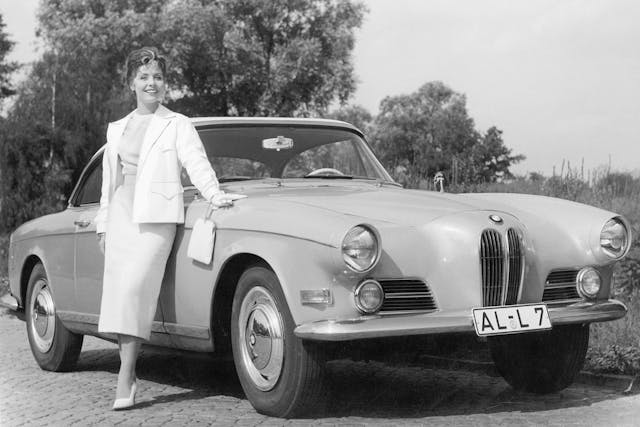
The 503 was never going to be a big seller. As a luxurious, hand-made, aluminum-bodied grand tourer, it would always be out of reach to the masses. But with its exquisite build quality, the 503 deserved better; each one was made to the specific requirements of its buyer, which is why no two cars were exactly the same.
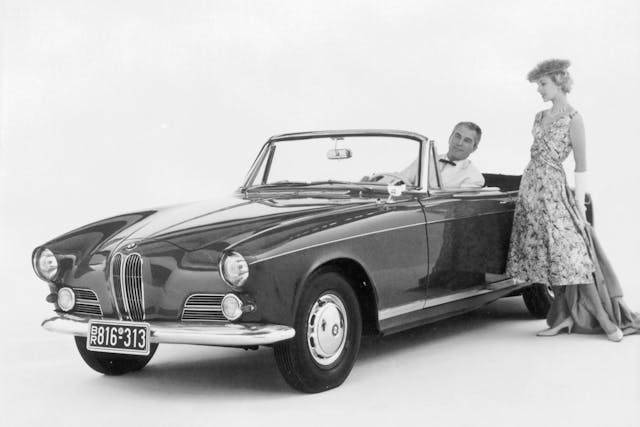
At launch there was a choice of coupe or cabriolet body style, both of which were based on the same substantial steel ladder frame. All 503s were fitted with a 3168-cc V-8 engine, which was an evolution of the 2580-cc unit first seen in the 502. Although V-8s were a staple of the major U.S. carmakers at this point, in Europe just three companies were producing such engines when BMW introduced the 502—the other two were Tatra and Ford France (in its Vedette). Rated at 140 hp at 4800 rpm, the 3300-pound BMW 503 was capable of 115 mph or so; these cars were always more about luxury than speed.
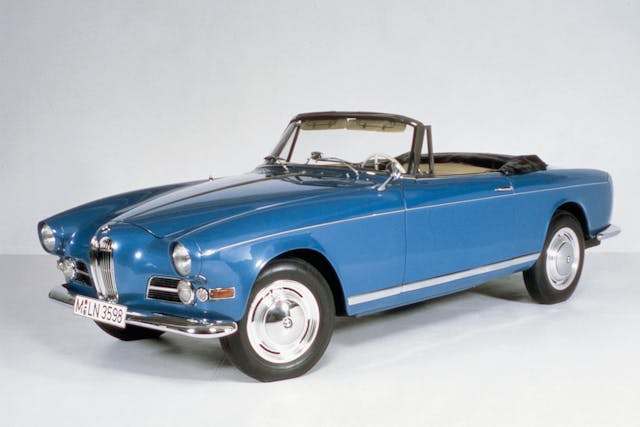
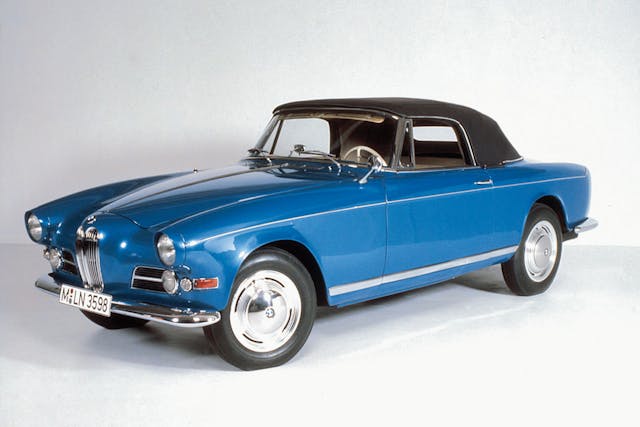
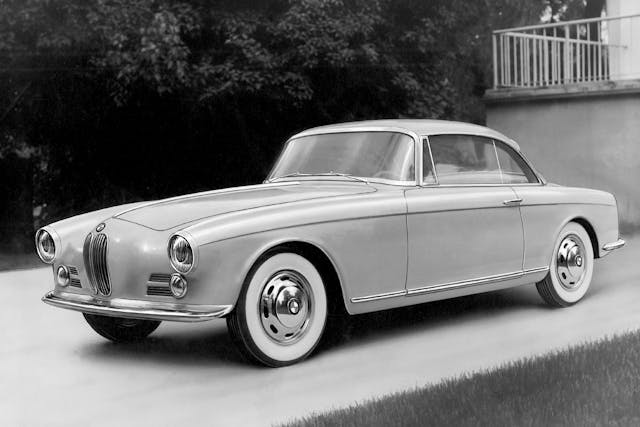
As if the high DM 29,500 (roughly $69K today) price tag wasn’t enough to push the 503 out of reach in standard form, BMW offered an array of extra-cost options for those with seriously deep pockets. All four side windows were activated electrohydraulically, while fog lamps and a brake servo were fitted as standard. However, customers could pay up to DM 38,000 (about $88,500) for a fully loaded 503 with a Becker self-seeking radio, windscreen washers, and posher wheel trims. Shorter gear ratios and individual paint finishes could also be specified.
The sales brochure also listed a semi-automatic transmission as an option, but all 503s were fitted with a four-speed manual gearbox which was positioned under the front seats to optimize weight distribution. To help cut weight, the engine block and heads, intake manifold, oil sump, timing cover, and bellhousing were all cast in aluminum, while fueling was courtesy of a pair of Zenith carburetors. Drum brakes were fitted front and rear (front discs were fitted from 1957), and the steering was a rack-and-pinion set-up.

The car was favorably reviewed by the press, but with no representation in the U.S. market and a massive price tag, BMW was fighting a losing battle with the 503, which was axed in spring 1959 after just 139 cabriolets and 274 coupes had been made. BMW hadn’t even come close to covering its development and production costs, a story that would hold true with the 503’s successor, the 3200 CS.
Of the 503s made, all featured left-hand drive, apart from a trio each of coupes and cabriolets. Racing driver John Surtees bought one of the latter, as well as a 507, and he kept both cars until his death in 2017. In light of their rarity, luxury, and fantastic build quality, today Hagerty values the 503 coupe at $121,000–$295,000 while cabriolets will fetch from $269,000 to $575,000. If you can find one…
***
Check out the Hagerty Media homepage so you don’t miss a single story, or better yet, bookmark it. To get our best stories delivered right to your inbox, subscribe to our newsletters.
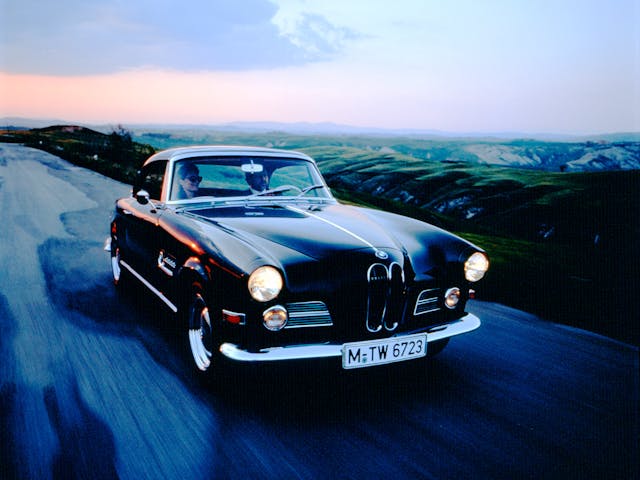











George C. Scott’s character drove a 503 cabriolet in 1971 movie, “The Last Run.” Not a horrible movie, but the car was a highlight.
Look Ma, a German Edsel!
Except worth a lot more than an Edsel now. 🙂
If only the grilles on current BMWs were so graceful. Beavertooth indeed.